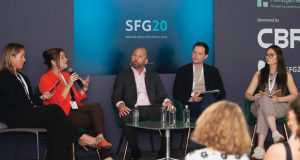AUDIENCE FEEDBACK
Opening the session out into the floor, a delegate proposed that the FM industry will need to change, because its core skill sets are in managing large amounts of space, which are predicted to be reduced over time. The concern was: “Within FM, context matters as not everyone can afford to think large scale.”
DW: “Thank you. I really like what you said about the correlation between the size of a company and the physical footprint, and I think you’re right. It is shrinking, but what we do with that footprint, that’s the richness, that’s the sexy stuff, that’s about how we are determining the services, the amenities. Seventy per cent of all employees have said that they consider their company based on the amenities, the wellbeing factors, the services that they provide inside the organisation. So I agree we’re changing work space, but what we do in there is so much richer than it ever was before.”
JH: “The question we can ask is: ‘does the built environment contribute to the culture, to the organisation’s success and productivity?’ I believe in most instances, the answer to that is yes.”
RW: “Things are going from people wanting to work in the shiniest office to looking for ‘place making’ services, particularly the generation that’s coming up. We need to design and operate buildings which do that.”
SJ: “What we’ve talked about here is experience, but it’s also about culture. What we do for our customers is important, so we invest a lot of money and insight into understanding them and would argue that the FM sector needs to do more of this. When you’re looking at the business case, what you need to invest in is the experience, which shows the money people that we have a demonstrable effective solution. Designing It is one thing but understanding how to fill the space is vital.”
DW: “I want to talk about one of my favourite examples ever. McDonald’s, about 15 years ago, was circling the drain. They were closing more stores than they were opening. Shareholders were freaking out. Share price was dropping. Nobody knew what to do. And then came the big meal deal and turned McDonald’s around. They started to open more stores. Shareholders were happy. The big meal deal was Coca Cola’s idea, as their service partner. Do you think they’re ever going to go to Pepsi? [In FM] how connected are you with the corporate businesses that you serve?”
DE: “I find the whole thing about people interesting because when I came into the facilities management sector, people were incidental. We were managing buildings, not people. People is a relatively new thing and now we’re managing their experience, their wellbeing, their expectation of what the office is delivering. But if we are modernising, should we be going to people’s homes and making sure the right equipment is there and the health and safety is as good as it is in the office? And in fact, the Leesman study has basically shown us that the average home office outperforms the average office. That is wrong as a sector, we need to shift that thinking around.”
AUDIENCE QUESTION
“How do we do better in FM at utilising our supply chain? Because whether it’s soft or hard FM, we utilise a lot of services via special service contractors. They bring value to the table as well. How do we best bring that forward to our clients?”
SJ: “Culture management. Everyone who works in our business has got ideas that we need to take forward, but critically – they’ve got to be given a platform. What we did was appeal to our leadership team, sending an email out to all our key MDs, to start thinking about their ideas before I began designing staff customer experience training. For me it’s the leadership mindset. You have got to embrace that your ideas are not just your own. We have to say there’s a different way of structuring things.”
DE: “I agree that individual responsibility is critical. I went to an FM service provider the other day and there was a mirror, and on that mirror was written; ‘You are the primary responsible person for health and safety at this office’. I think that says it all.”
RW: “I would advise, involve your support partners in the strategy, not just the tactics, and it’s the same vision. Make them part of the team and I would just add, be curious. Have a childlike curiosity about your client.”
DW: “Figure out what they stand for, what their business objectives are, what are they grappling with? What do they enjoy doing? What do they hate doing? Where are their biggest risks and how can your organisation help them?”
JH: “As providers, we’ve got to stop thinking about trying to sell our services and start thinking about what is of value to the customer, wherever they sit in the supply chain. Just one little example of that from our clients. We’ve talked to them about CAFM solutions but we’re agnostic. One client was going to procure a system at a significant cost, but we helped them choose a more suitable solution, which is a game changer, because that becomes a part of their strategic journey. It means we’re adding value to the organisation’s business outside [the traditional] scope of FM.”
Concluding the session, David Emanuel said: “I’d like to thank you all for attending this session. I hope you offered value out of it, let me sort of challenge your perception of where we are and where we need to get to.”






